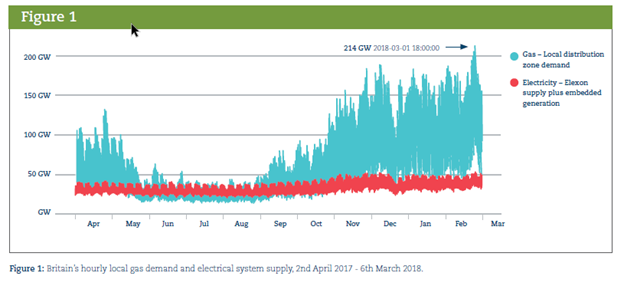Heat Pumps - Good, Bad or Ugly?
Heat pumps can reduce energy use or heating by as much as 80%, but they place a huge peak load on the electrical grid which may be hard to accommodate with carbon free power.
Heat pumps are a great way to reduce energy use, and if the electricity they use is from carbon-free sources, building heating would no longer be a source of CO2 emissions. My own home is heated by heat pumps, and they work year-round, in winter as heaters and in summer as air conditioners.
The UK and much of Europe are hoping that heat pumps will replace gas as a source of building heat in the quest for Net Zero emissions.
But there is a flaw in the plan that I don’t think has been carefully considered. The chart below is from a report produced by the UK Energy Research Centre:
It shows gas and electricity demand for an 11-month period from April 2017 to March 2018. There are two things to note:
1. Natural gas supplies a lot more energy than electricity does (the chart is locally distributed gas, it does not include gas supplied to generate electricity).
2. The seasonal variation for gas demand is significantly greater than the variation in electricity demand. Peak electricity demand is about 50% higher than average demand, but peak gas demand is 3 to 4 times higher than average demand.
Air source heat pumps operate by extracting heat from the outside air and transferring it to the building. They can transfer as much as 4 times the energy that they use, but when it’s cold outside there is a lot less heat in the outside air. The efficiency drops from around 400% to somewhere between 200 and 300% when the temperature drops below freezing.
Although a heat pump can reduce the energy use by a factor of 5 compared to the average gas boiler, when outdoor temperatures fall below zero degrees Celsius that reduction in energy use is likely to be closer to 3 times.
The 214 GW peak gas use, replaced by heat pumps would translate to about 70 GW peak electrical demand in addition to the 50 GW normal peak demand. Those peaks are likely to occur at the same time. That’s a 140% increase in peak electrical demand if all gas building heat is to be replaced by heat pumps.
Cold spells happen in winter when solar power is at its weakest, so we cannot count on solar power being of much use in meeting peak demand.
One of the common weather systems that results in prolonged exceptional cold is a slow-moving high-pressure system that brings cold air from the Arctic. That type of system is also accompanied by low winds, so wind power is also likely to be of little use in meeting the demand peak.
There is a very good chance that the 120 GW peak electrical demand will happen at a time when there is almost no power generation from wind and solar.
Gas can be stored in underground salt caverns, the delivery pipelines also act as a buffer, the amount of gas stored varies as the pressure in the pipeline changes. This provides a natural buffer to smooth out supply and demand, but electricity has no such buffer, it must be delivered on demand or the whole system collapses.
The peak daily gas demand for the period in the chart was 3,920 GWh, and demand remained above 3,000 GWh for at least 5 days. Conversion to heat pumps would reduce that demand to about 1 Twh per day. Supplying that demand as well as the normal electrical demand for a week when wind and solar are hardly producing anything would need at least 5 TWh of batteries costing about $1.5 trillion.
Batteries are not a practical solution, they are far too expensive to be used as backup power for cold spells that might happen only once or twice a year, and in any case there is no guarantee that the batteries could be charged sufficiently in between periods of low wind and solar production.
Dealing with extreme demand peaks in an electrical system is a major problem. Most electrical generation is capital intensive with high fixed costs and low variable costs that don’t easily accommodate massive spikes in demand.
I see the UK government is strongly pushing for conversion to heat pumps, along with a build-out of wind and solar, but I have not seen any proposal as to how they might tackle this demand spike issue with such a system.


